Ultrasonic Orbital Microforming—A New Possibility in the Forming of Microparts
Abstract
:1. Introduction
2. Materials and Methods
3. Results
4. Discussion
- The process concerned microproducts and therefore there was a very large power reserve of the oscillatory system, which caused the system not to become damped, which then changed the system’s parameters during the deformation process;
- The so-called “dynamic effect” was present, which meant that in the conditions of the conducted process, periodic loss of contact between the punch and the sample was possible;
- Punch vibration in connection with a periodic contact with a specimen caused an acceleration in rotational motion; and
- Rapid rotational motion caused a gyroscopic moment, which stabilized the position of the sample in space.
- Local periodic temperature increases related to friction in temporary contact areas of the tool and the sample;
- Local periodic temperature increases related to the generation of heat resulting from intense periodic plastic deformation in the contact areas;
- Periodic homogenization of the temperature distribution during periods of material deformation, as seen in the free stroke in Figure 6; and
- Thermally and mechanically generated structural changes as part of periodic deformation.
Possible Industrial Applications
5. Conclusions
- Using microforming conditions with the use of ultrasonic vibrations, it is possible to carry out a previously unknown method of metal forming, called ultrasonic orbital microforming.
- The UOM method leads to obtaining microproducts with shapes analogous to the products obtained at the macroscale using classic orbital forming methods, which was demonstrated by FEM modeling.
- The mechanisms of deformation in the UOM method are fundamentally different from those occurring in orbital forming macroprocesses, and cannot occur in such processes. The main difference is the use of dynamic effects, such as the gyroscopic effect.
- The presented UOM mechanism is qualitatively consistent with the results obtained. However, the detailed course of phenomena and their quantitative assessment requires further research and analysis.
Funding
Conflicts of Interest
Appendix A. Compensation of the Elastic Deflection of the Load System
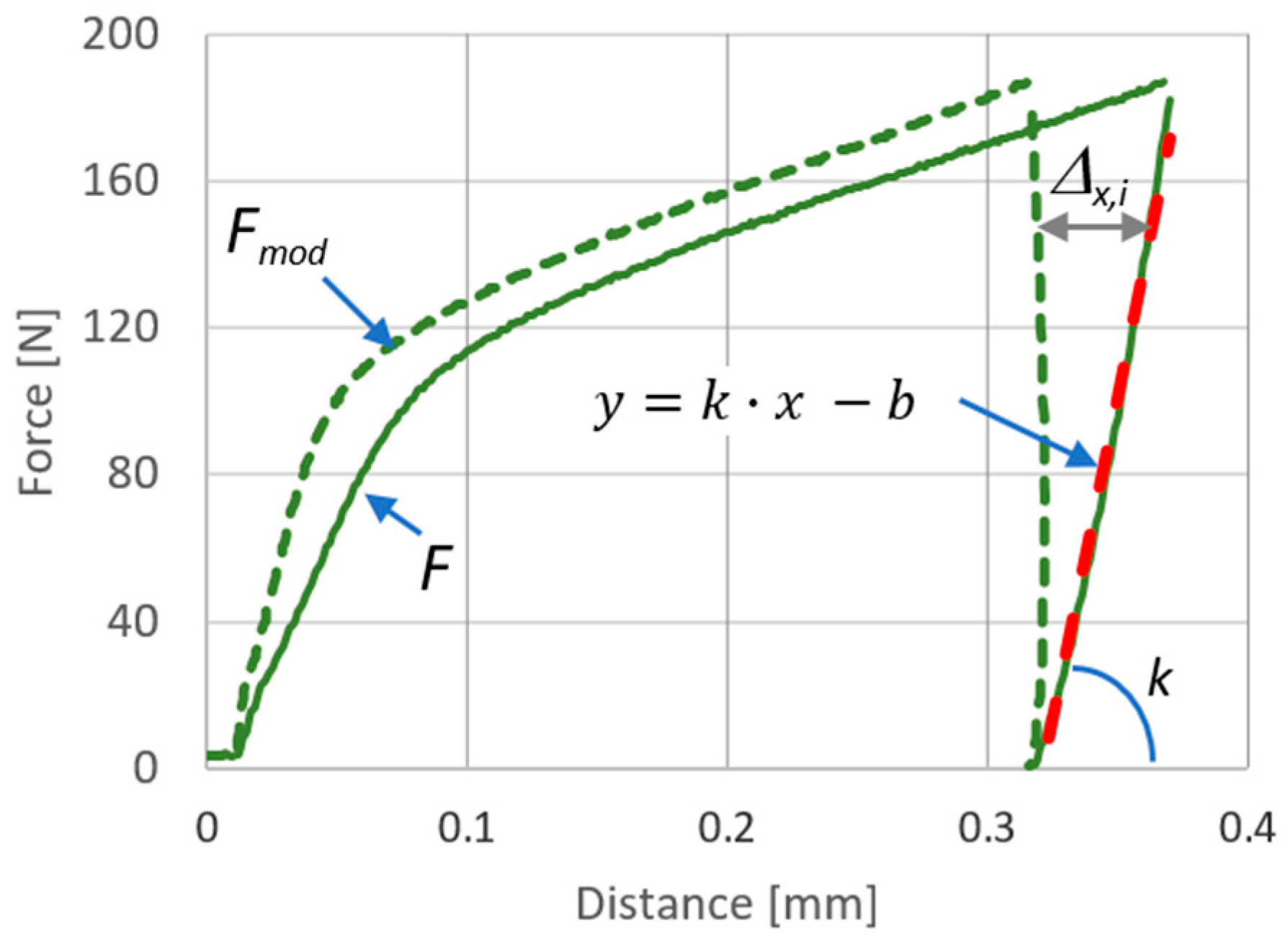
Appendix B. Orbital Forming
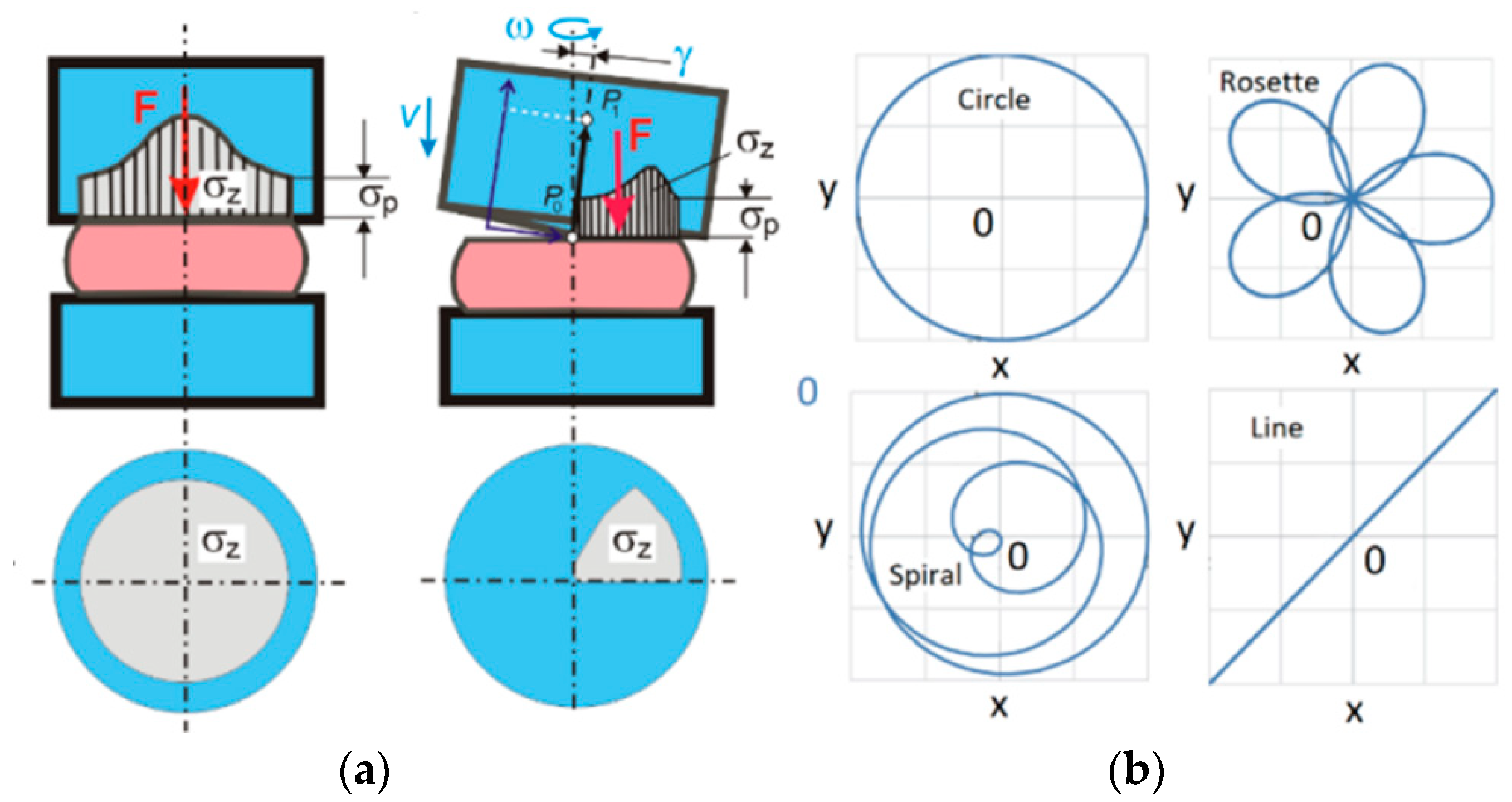
References
- Santome, Y.; Hiroyuki, I. Superplastic backward microextrusion of microparts for micro-electro-mechanical systems. J. Mater. Process. Technol. 2001, 119, 307–311. [Google Scholar] [CrossRef]
- Geiger, M.; Engel, U.; Vollertsen, F.; Kals, R.; Meßner, A. Metal forming of micro parts for electronics. Prod. Eng. 1994, 2, 15–18. [Google Scholar] [CrossRef]
- Engel, U.; Rosochowski, A.; Geißdörfer, S.; Olejnik, L. Microforming and Nanomaterials. In Advances in Material Forming: Esaform 10 Years on; Springer Science & Business Media: Berlin, Germany, 2007; ISBN 9782287721427. [Google Scholar]
- Geiger, M.; Kleiner, M.; Eckstein, R.; Tiesler, N.; Engel, U. Microforming. CIRP Ann. 2001, 50, 445–462. [Google Scholar] [CrossRef]
- Taureza, M.; Song, X.; Castagne, S. On the influence of workpiece material on friction in micro forming and lubricant effectiveness. J. Mater. Process. Technol. 2014, 214, 998–1007. [Google Scholar] [CrossRef]
- Engel, U. Tribology in microforming. Wear 2006, 260, 265–273. [Google Scholar] [CrossRef]
- Jeon, J.; Bramley, A.N. A friction model for microforming. Int. J. Adv. Manuf. Technol. 2007, 33, 125–129. [Google Scholar] [CrossRef]
- Wang, C.; Guo, B.; Shan, D. Friction related size-effect in microforming—A review. Manuf. Rev. 2014, 1, 23. [Google Scholar] [CrossRef]
- Muster, A.; Presz, W. Influence of initial surface roughness on galling behaviour of steel-steel couple. Scand. J. Metall. 1999, 28, 5–8. [Google Scholar]
- Presz, W.; Kaczorowski, M. Strengthening Mechanisms of 1H18N9T Austenitic Steel Buildups Created with Cold Forming Processes. Adv. Mater. Res. 2007, 23, 165–168. [Google Scholar] [CrossRef]
- Shimizu, T.; Komiya, H.; Watanabe, T.; Teranishi, Y.; Nagasaka, H.; Morikawa, K.; Yang, M. HIPIMS deposition of TiAlN films on inner wall of micro-dies and its applicability in micro-sheet metal forming. Surf. Coat. Technol. 2014, 250, 44–51. [Google Scholar] [CrossRef]
- Presz, W. Contact Phenomena in Micro-Blanking. Int. J. Mater. Form. 2008, 1, 471–474. [Google Scholar] [CrossRef]
- Wang, C.; Guo, B.; Shan, D.; Zhang, M.; Bai, X. Tribological behaviors in microforming considering microscopically trapped lubricant at contact interface. Int. J. Adv. Manuf. Technol. 2014, 71, 2083–2090. [Google Scholar] [CrossRef]
- Golanski, D.; Dymny, G.; Kujawińska, M.; Tomasz, C. Experimental investigation of displacement/strain fields in metal coatings deposited on ceramic substrates by thermal spraying. Solid State Phenom. 2016, 240, 174–182. [Google Scholar] [CrossRef]
- Shimizu, T.; Kakegawa, T.; Yang, M. Micro-texturing of DLC thin film coatings and its tribological performance under dry sliding friction for microforming operation. Proc. Eng. 2014, 81, 1884–1889. [Google Scholar] [CrossRef]
- Diehl, A.; Engel, U.; Geiger, M. Influence of microstructure on the mechanical properties and the forming behaviour of very thin metal foils. Int. J. Adv. Manuf. Technol. 2010, 47, 53–61. [Google Scholar] [CrossRef]
- Chan, W.L.; Fu, M.W.; Yang, B. Experimental studies of the size effect affected microscale plastic deformation in micro upsetting process. Mater. Sci. Eng. A 2012, 534, 374–383. [Google Scholar] [CrossRef]
- Kocanda, A.; Presz, W.; Adamczyk, G.; Czyżewski, P.; Mazurek, M. Contact pressure distribution in upsetting of compound metals. J. Mater. Process. Technol. 1996, 60, 343–348. [Google Scholar] [CrossRef]
- Presz, W.; Rosochowski, A. The Influence of Grain Size on Surface Quality of Microformed Components. In Proceedings of the 9th International ESAFORM Conference on Material Forming, Glasgow, UK, 26–28 April 2006. [Google Scholar]
- Ghassemali, E.; Tan, M.J.; Wah, C.B.; Jarfors, A.E.W.; Lim, S.C.V. Grain size and workpiece dimension effects on material flow in an open-die micro-forging/extrusion process. Mater. Sci. Eng. A 2013, 582, 379–388. [Google Scholar] [CrossRef]
- Chang, T.A.; Razali, A.R.; Zainudin, N.A.I.; Yap, W.L. Size Effects in Thin Sheet Metal Forming. In Proceedings of the 3rd International Conference of Mechanical Engineering Research, Kuantan, Malaysia, 18–19 August 2015. [Google Scholar]
- Ran, J.Q.; Fu, M.W.; Chan, W.L. The influence of size effect on the ductile fracture in micro-scaled plastic deformation. Int. J. Plast. 2013, 41, 65–81. [Google Scholar] [CrossRef]
- Raulea, L.V.; Goijaerts, A.M.; Govaert, L.E.; Baaijens, F.P.T. Size effect in the processing of thin metal sheets. J. Mater. Process. Technol. 2001, 115, 44–48. [Google Scholar] [CrossRef]
- Presz, W.; Andersen, B.; Wanheim, T. Piezoelectric driven Micro-press for microforming. J. Achiev. Mater. Manuf. Eng. 2006, 18, 411–414. [Google Scholar]
- Cannella, E.; Nielsen, E.K.; Stolfi, A. Designing a Tool System for Lowering Friction during the Ejection of In-Die Sintered Micro Gears. Micromachines 2017, 8, 214. [Google Scholar] [CrossRef]
- Paldan, N.A.; Arentoft, M.; Eriksen, R.S.; Mangeot, S. Piezo driven prestressing of die-system for microforming of metal components. Int. J. Mater. Form. 2008, 1, 467–470. [Google Scholar] [CrossRef]
- Presz, W. Scale effect in design of the pre-stressed micro-dies for microforming. Comput. Meth. Mater. Sci. 2016, 16, 196–203. [Google Scholar]
- Presz, W.; Rosochowski, M. Application of semi-physical modeling of interface surface roughness in design of pre-stressed microforming dies. Proc. Eng. 2017, 207, 1004–1009. [Google Scholar] [CrossRef]
- Wang, C.J.; Shan, D.B.; Zhou, J.; Guo, B.; Sun, L.N. Size effects of the cavity dimension on the microforming ability during coining process. J. Mater. Proc. Technol. 2007, 187, 256–259. [Google Scholar] [CrossRef]
- Ghassemali, E.; Jarfors, A.E.W.; Tan, M.J.; Lim, S.C.V. On the microstructure of micro-pins manufactured by a novel progressive microforming process. Int. J. Mater. Form. 2013, 6, 65–74. [Google Scholar] [CrossRef]
- Stellin, T.; van Tijum, R.; Engel, U. Modelling and experimental study of a microforging process from metal strip for the reduction of defects in mass production. Prod. Eng. 2016, 10, 103–112. [Google Scholar] [CrossRef]
- Gong, F.; Guo, B. Size effects on mechanical properties of copper thin sheet in uniaxial tensile tests. Medziagotyra. 2014, 20, 509–512. [Google Scholar] [CrossRef]
- Presz, W. The Method of Micro-Upsetting in Uneven Temperature Distribution. In Proceedings of the 27th International Conference on Metallurgy and Materials, Brno, Czech Republic, 23–25 May 2018. [Google Scholar]
- Wulfsberg, J.P.; Terzi, M. Investigation of laser heating in microforming applying sapphire tools. CIRP Ann. Manuf. Technol. 2007, 56, 321–326. [Google Scholar] [CrossRef]
- Li, Y.; Quick, N.R.; Kar, A. Dieless laser drawing of fine metal wires. J. Mater. Process. Technol. 2002, 123, 451–458. [Google Scholar] [CrossRef]
- Gao, H.; Cheng, G.J. Laser-induced high-strain-rate superplastic 3-D microforming of metallic thin films. J. Microelectromech. Syst. 2010, 19, 273–281. [Google Scholar] [CrossRef]
- Liu, H.-X.; Li, J.-W.; Zhang, Q.; Shen, Z.-B.; Qian, Q.; Zhang, H.-F.; Wang, X. Warm microforming using a laser-driven flyer. Lasers Eng. 2017, 36, 89–102. [Google Scholar]
- Je, G.; Malka, D.; Kim, H.; Hong, S.; Shin, B. A study on micro hydroforming using shock wave of 355 nm UV-pulsed laser. Appl. Surf. Sci. 2017, 417, 244–249. [Google Scholar] [CrossRef]
- Presz, W. The Influence of Punch Vibration on Surface Phenomena in Micro-Extrusion. In Proceedings of the 9th International ESAFORM Conference on Material Forming, Glasgow, UK, 26–28 April 2006. [Google Scholar]
- Ngaile, G.; Bunget, C. Influence of ultrasonic vibration on microforming. Trans. NAMRI/SME 2008, 36, 137–144. [Google Scholar]
- Dawson, G.R.; Winsper, C.E.; Snasome, D.H. Application of high- and low-frequency oscillation to the plastic deformation of metals. Met. Form. 1970, 37, 254–261. [Google Scholar]
- Presz, W. The Method of Determining the Tendency to Galling in Vibration Assisted Microforming. In Proceedings of the 27th International Conference on Metallurgy and Materials, Brno, Czech Republic, 23–25 May 2018. [Google Scholar]
- Djavanroodi, F.; Ahmadian, H.; Koohkan, K.; Naseri, R. Ultrasonic assisted-ECAP. Ultrasonics 2013, 53, 1089–1096. [Google Scholar] [CrossRef] [PubMed]
- Gale, E.; Nevill, J.F. The Effect of Vibrations on the Static Yield Strength of a Low–Carbon Steel. ASTM Proc. 1957, 57, 751–758. [Google Scholar]
- Blaha, F.; Langenecker, B. Plastizitätsuntersuchungen von metallkristallen in ultraschallfeld. Acta Metall. 1959, 7, 93–100. [Google Scholar] [CrossRef]
- Daud, Y.; Lucas, M.; Huang, Z. Modelling the effects of superimposed ultrasonic vibrations on tension and compression tests of aluminium. J. Mater. Process. Technol. 2007, 186, 179–190. [Google Scholar] [CrossRef]
- Siddiq, A.; El Sayed, T. Acoustic softening in metals during ultrasonic assisted deformation via CP-FEM. Mater. Lett. 2011, 65, 356–359. [Google Scholar] [CrossRef]
- Siu, K.W.; Ngan, A.H.W. Understanding acoustoplasticity through dislocation dynamics. Philos. Mag. 2011, 91, 4367–4387. [Google Scholar] [CrossRef] [Green Version]
- Lum, I.; Huang, H.; Chang, B.H.; Mayer, M.; Du, D.; Zhou, Y. Effects of superimposed ultrasound on deformation of gold. J. Appl. Phys. 2009, 105, 902–905. [Google Scholar] [CrossRef]
- Abhishek, P.; Verma, G.C.; Hariharan, K.; Pandey, P.M.; Lee, M.G.; Suwas, S. Dislocation density based constitutive model for ultrasonic assisted deformation. Mech. Res. Commun. 2017, 85, 76–80. [Google Scholar]
- Mordyuk, B.M.; Karasevs’Ka, O.P.; Rudoi, P.E.; Skyba, I.O.; Kamins’Kyi, H.H. Influence of ultrasonic vibrations on the phase transformation and strain hardening of a Zr18Nb alloy in tension. Mater. Sci. 2013, 48, 546–554. [Google Scholar] [CrossRef]
- Presz, W.; Kulik, T. Ultrasonic vibrations as an impulse for glass transition in micro-forming of bulk metallic glass. Arch. Civ. Mech. Eng. 2018, 19, 100–113. [Google Scholar] [CrossRef]
- Myshlyaev, M.M.; Shpeizman, V.V.; Klubovich, V.V.; Kulak, M.M.; Lyu, G. Change in Characteristics of Superplastic Deformation of the Aluminum–Lithium Alloy under the Effect of Ultrasonic Vibrations. Phys. Solid State 2015, 57, 2039–2044. [Google Scholar] [CrossRef]
- Zhou, H.; Cui, H.; Qin, Q.H.; Wang, H.; Shen, Y. A comparative study of mechanical and microstructural characteristics of aluminium and titanium undergoing ultrasonic assisted compression testing. Mater. Sci. Eng. A 2017, 682, 376–388. [Google Scholar] [CrossRef]
- Luo, F.; Li, K.; Zhong, J.; Gong, F.; Wu, X.; Ruan, S. An ultrasonic microforming process for thin sheet metals and its replication abilities. J. Mater. Process. Technol. 2015, 216, 10–18. [Google Scholar] [CrossRef]
- Bunget, C.; Ngaile, G. Influence of ultrasonic vibration on micro-extrusion. Ultrasonics 2011, 51, 606–616. [Google Scholar] [CrossRef] [PubMed] [Green Version]
- Presz, W.; Cacko, R. Ultrasonic assisted microforming. In Proceedings of the METAL 2017–26th International Conference on Metallurgy and Materials, Brno, Czech Republic, 24–26 May 2017. [Google Scholar]
- Hu, J.; Shimizu, T.; Yang, M.I. Investigation on ultrasonic volume effects: Stress superposition, acoustic softening and dynamic impact. Ultrason. Sonochem. 2018, 48, 240–248. [Google Scholar] [CrossRef] [PubMed]
- Presz, W. Dynamic effect in ultrasonic assisted micro-upsetting. In Proceedings of the AIP Conference Proceedings, Palermo, Italy, 23–25 April 2018. [Google Scholar]
- Schondelmaier, J. Grundlagenuntersuchung uber das Taumelpressen; Springer: Berlin/Heidelberg, Germany, 1992. [Google Scholar]
- Han, X.; Hua, L. Comparison between cold rotary forging and conventional forging. J. Mech. Sci. Technol. 2009, 23, 2668–2678. [Google Scholar] [CrossRef]
- Plancak, M.E.; Vilotic, D.Z.; Stefanovic, M.C. Orbital Forging—A plausible alternative for bulk metal forging. Trends Dev. Mach. Assoc. Technol. 2012, 16, 63–66. [Google Scholar]
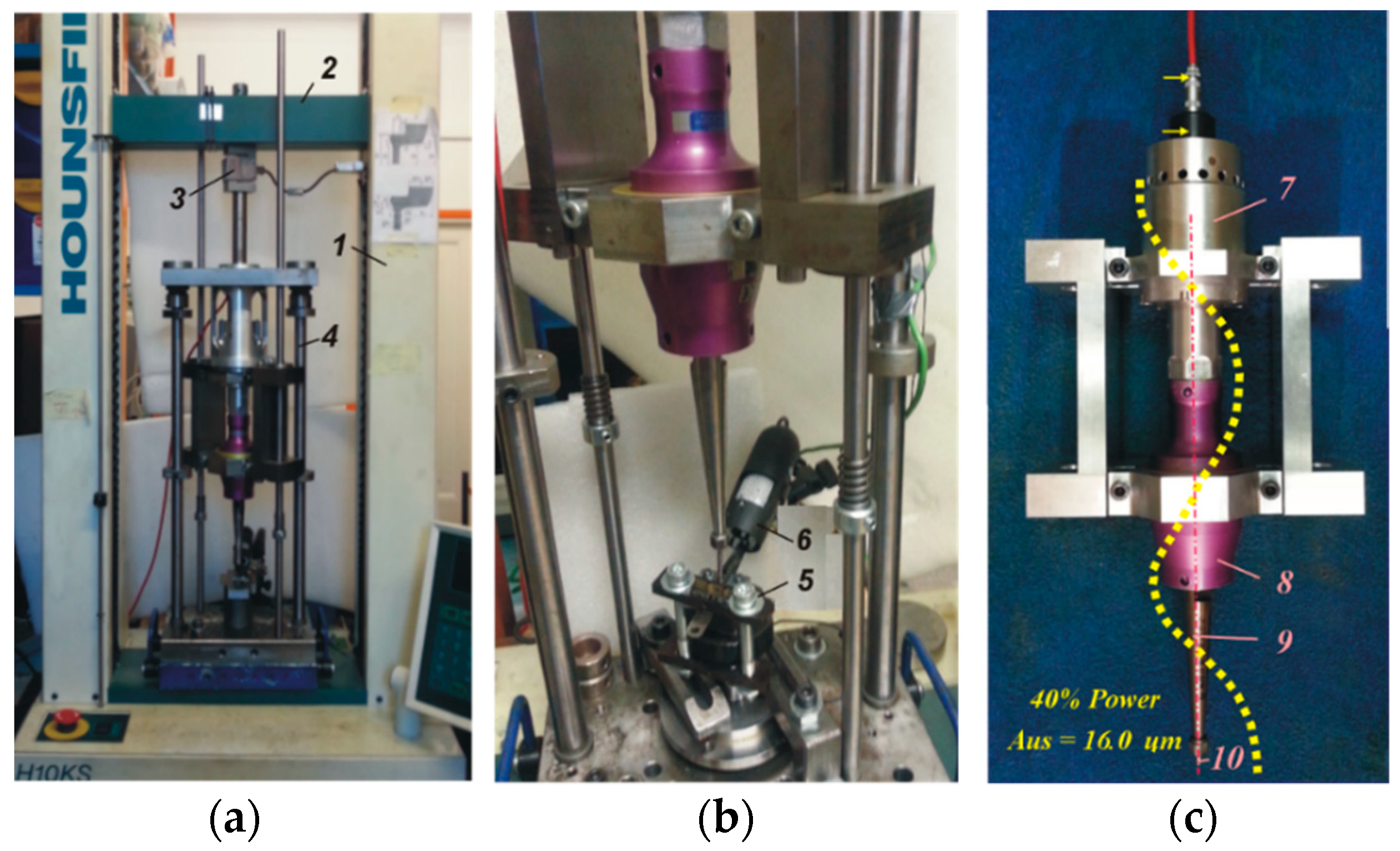

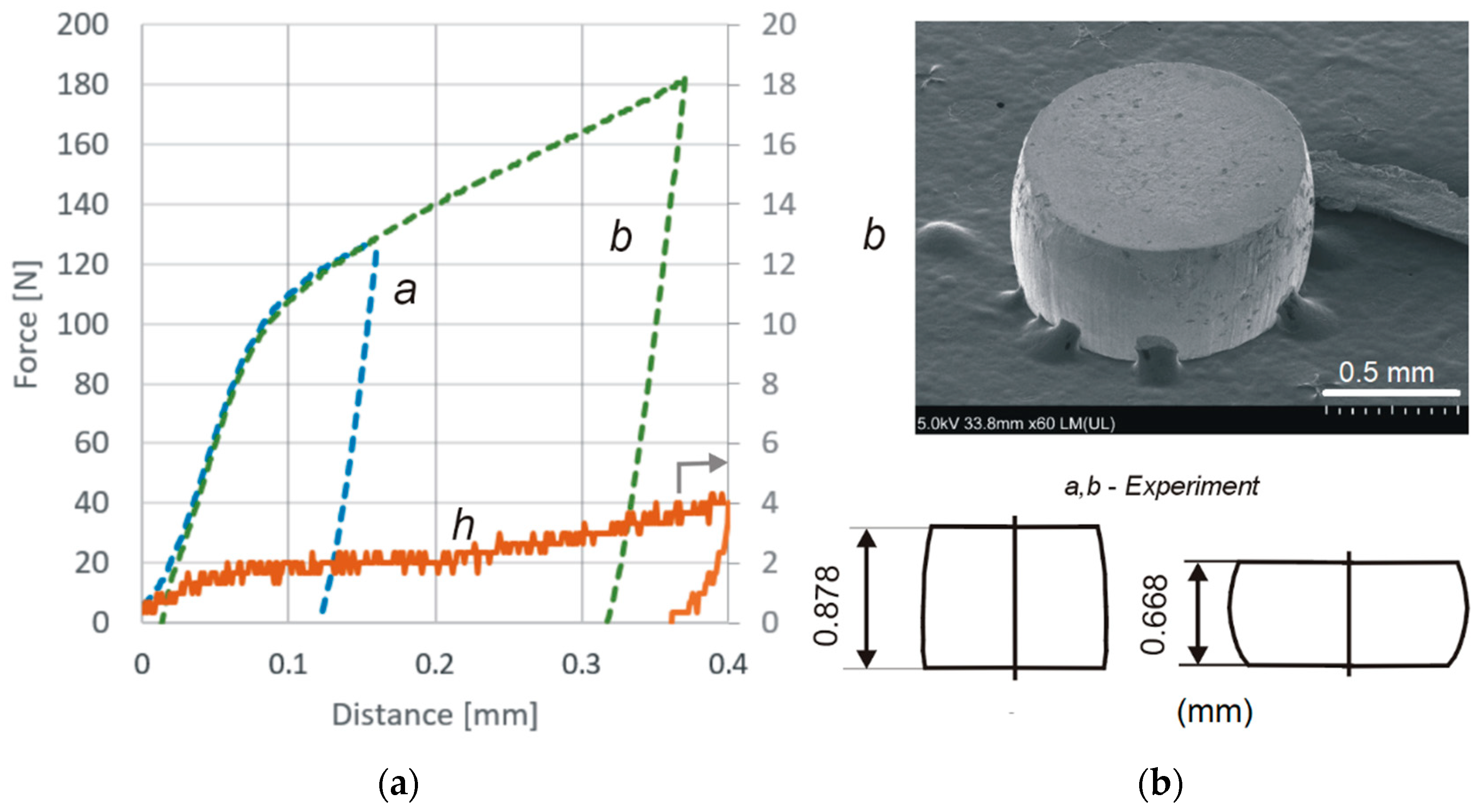

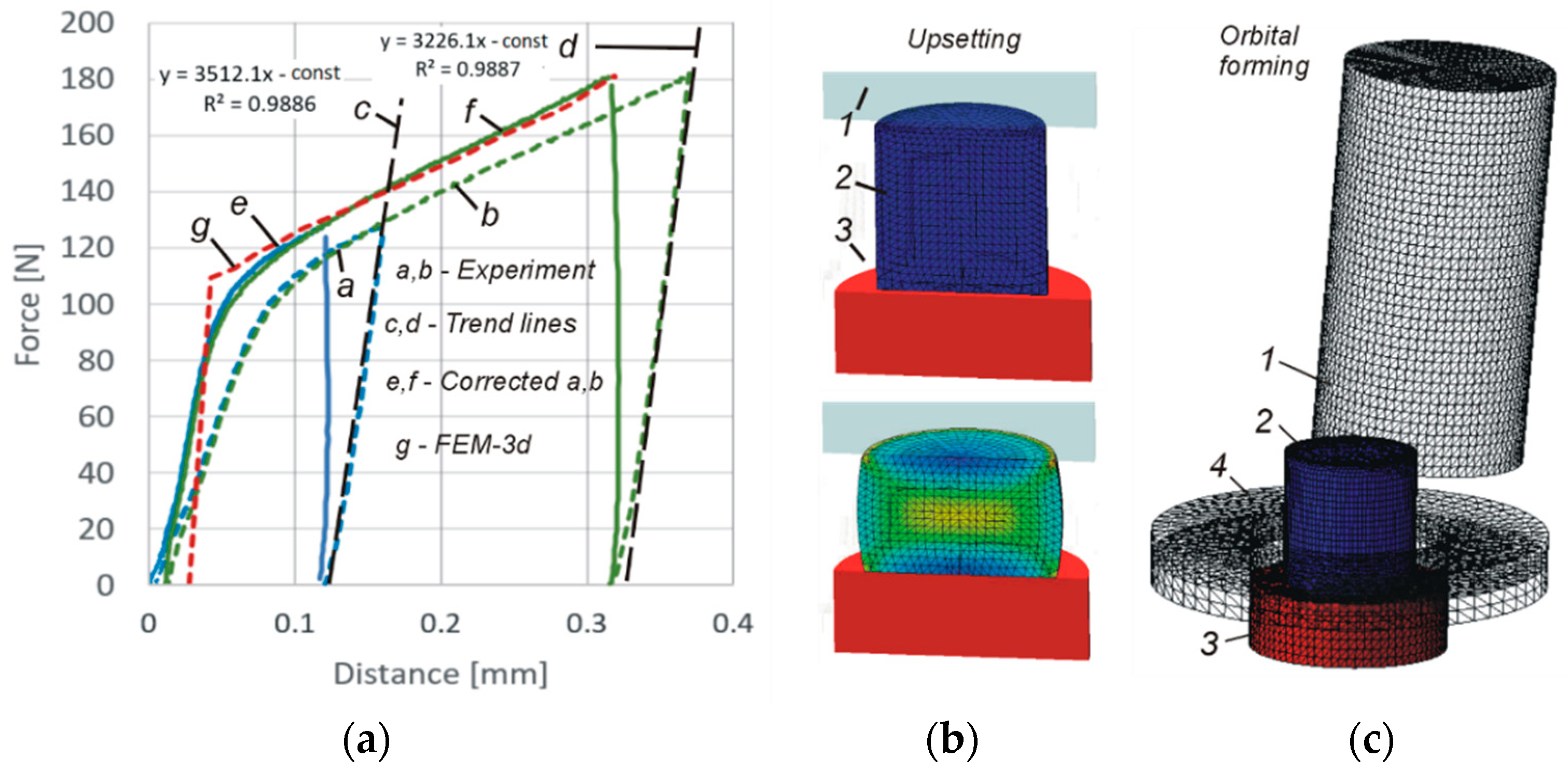

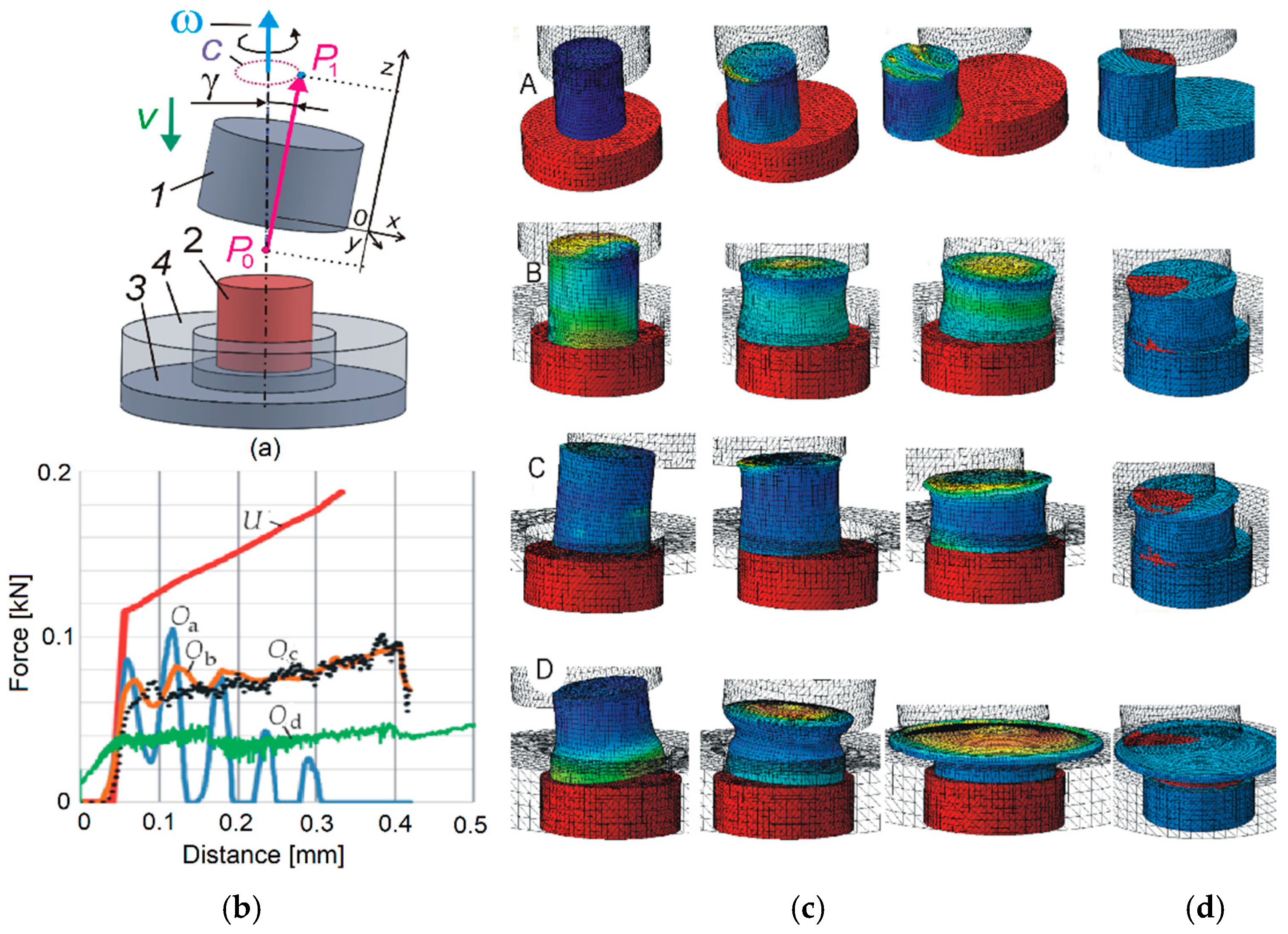

| E (GPa) | Re (MPa) | ν (1) | C (MPa) | n (1) |
|---|---|---|---|---|
| 70 | 135 | 0.32 | 174 | 0.05 |
| Temp (°C) | Punch and Anvil (µm) | Ram vel. down (mm/min) | Ram vel. up (mm/min) | Lubricant | Ram Control | Vib. freq. (kHz) | Vib. amp. (μm) |
|---|---|---|---|---|---|---|---|
| 22 | Ra = 0.63 | 0.2 | 0.02 | Light oil | Stroke | 20 | 16 |
| Process | γ | ω | V | z0 | z1 |
|---|---|---|---|---|---|
| (orbital) | (deg) | (rpm) | (mm/s) | (mm) | (mm) |
| Oa | 4 | 6000 | 6 | −4 | 0 |
| Ob | 4 | 6000 | 6 | −4 | 0 |
| Oc | 4 | 6000 | 6 | −7.2 | 0 |
| Od | 8 | 800 | 0.2 | −2 | 0 |
© 2018 by the author. Licensee MDPI, Basel, Switzerland. This article is an open access article distributed under the terms and conditions of the Creative Commons Attribution (CC BY) license (http://creativecommons.org/licenses/by/4.0/).
Share and Cite
Presz, W. Ultrasonic Orbital Microforming—A New Possibility in the Forming of Microparts. Metals 2018, 8, 889. https://doi.org/10.3390/met8110889
Presz W. Ultrasonic Orbital Microforming—A New Possibility in the Forming of Microparts. Metals. 2018; 8(11):889. https://doi.org/10.3390/met8110889
Chicago/Turabian StylePresz, Wojciech. 2018. "Ultrasonic Orbital Microforming—A New Possibility in the Forming of Microparts" Metals 8, no. 11: 889. https://doi.org/10.3390/met8110889





